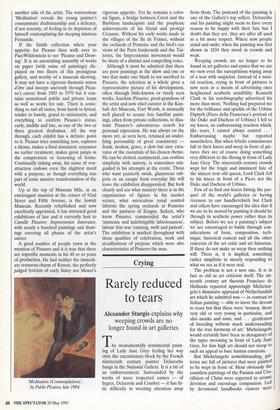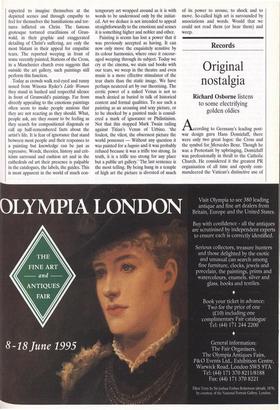Crying
Rarely reduced to tears
Alexander Sturgis explains why weeping crowds are no longer found in art galleries
The monumentally sentimental paint- ing of Lady Jane Grey feeling her way onto the executioners block by the French nineteenth century painter Delaroche hangs in the National Gallery. It is a bit of an embarrassment. Surrounded by the works of more respected names — of Ingres, Delacroix and Courbet — it has lit- tle difficulty in wresting attention away from them. The postcard of the painting is one of the Gallery's top sellers. Delaroche and his painting might seem to have every reason to be happy with their fate but I doubt that they are. they are after all used to a bit more respect. Where now people stand and smile, when the painting was first shown in 1834 they stood in crowds and wept.
Weeping crowds are no longer to be found in art galleries and cynics that we are we view even the surreptitious wiping away of a tear with suspicion. Instead of a natu- ral reaction, crying in front of pictures is now seen as a means of advertising ones heightened aesthetic sensibility. Kenneth Clark in his autobiography advertised his more than most, 'Nothing had prepared me for the brilliance and sparkle of the Urbino Diptych (Piero della Francesca's portrait of the Duke and Duchess of Urbino) I fell to my knees, an embarrassing reaction which, like tears, I cannot always control . . . ' Embarrassing maybe but reported nonetheless. But when febrile connoisseurs fall to their knees and weep in front of pic- tures they are of course doing something very different to the throng in front of Lady Jane Grey. The nineteenth century crowds wept for the tragic and imminent fate of the sixteen year old queen, Lord Clark fell to his knees in front of a Piero not the Duke and Duchess of Urbino.
Few of us find our knees hitting the par- quet of the world's galleries or having recourse to our handkerchiefs but Clark and others have encouraged the idea that if we are to be moved by painting it should be through its aesthetic power rather than its subject. Before we see a painting's subject we are encouraged to battle through con- siderations of form, composition, tech- nique, historical context and all the other concerns of the art critic and art historian. If these do not make us weep then nothing will. There is, it is implied, something rather simplistic in merely responding to what we see as if it were real.
The problem is not a new one. It is in fact as old as art criticism itself. The six- teenth century art theorist Francisco de Hollanda reported approvingly Michelan- gelo's dismissive appraisal of Netherlandish art which he admitted was — in contrast to Italian painting — able to move the devout to tears but that these were 'women, those very old or very young in particular, and also monks and nuns, and . . . gentlemen of breeding without much understanding for the true harmony of art.' Michelangelo would certainly have been as derogatory of the types swooning in front of Lady Jane Grey, for him high art should not stoop to such an appeal to base human emotions. But Michelangelo notwithstanding, gal- leries are full of pictures that were painted to be wept in front of. Most obviously the countless paintings of the Passion and Cru- cifixion of Christ were expected to arouse devotion and encourage compassion. Led by devotional handbooks viewers were expected to imagine themselves at the depicted scenes and through empathy to feel for themselves the humiliations and tor- tures inflicted on Christ. The famous grotesque tortured crucifixions of Grun- wald, in their graphic and exaggerated detailing of Christ's suffering, are only the most blatant in their appeal for empathic tears. The reported weeping in front of some recently painted, Stations of the Cross, in a Manchester church even suggests that outside the art gallery, such paintings still perform this function.
Today as crowds walk red-eyed and runny nosed from Winona Ryder's Little Women they stand in hushed and respectful silence in front of Grunwald's paintings. Far from directly appealing to the emotions paintings often seem to make people anxious that they are not reacting as they should. What, people ask, are they meant to be feeling as they search for compositional diagonals or call up half-remembered facts about the artist's life. It is fear of ignorance that stand between most people and their responses to a painting but knowledge can be just as repressive. Words, theories, history and crit- icism surround and cushion art and in the cathedrals od art their presence is palpable in the catalogues, the labels, the guides. This is most apparent in the world of much con- temporary art wrapped around as it is with words to be understood only by the initiat- ed. Art we deduce is not intended to appeal straightforwardly to the emotions and senses it is something higher and nobler and other.
Painting is seems has lost a power that it was previously accepted as having. It can now only move the exquisitely sensitive by its colour harmonies, where once it encour- aged weeping through its subject. Today we cry at the cinema, we stain sad books with our tears, we weep in the theatre and even music is a more effective stimulator of the tear ducts than the static image. We have perhaps neutered art by our theorising. The erotic power of a naked Venus is not so much denied as buried in talk of historical context and formal qualities. To see such a painting as an arousing and sexy picture, or to be shocked by a painted nude is consid- ered a mark of ignorance or Philistinism. Not that this stopped Mark Twain railing against Titian's Venus of Urbino. 'the foulest, the vilest, the obscenest picture the world possesses — Without any question it was painted for a bagnio and it was probably refused because it was a trifle too strong. In truth, it is a trifle too strong for any place but a public art gallery.' The last sentence is the most telling. By being hung in a temple of high art the picture is divested of much of its power to arouse, to shock and to move. So-called high art is surrounded by associations and words. Would that we could not read them (or hear them) and weep.



































































 Previous page
Previous page